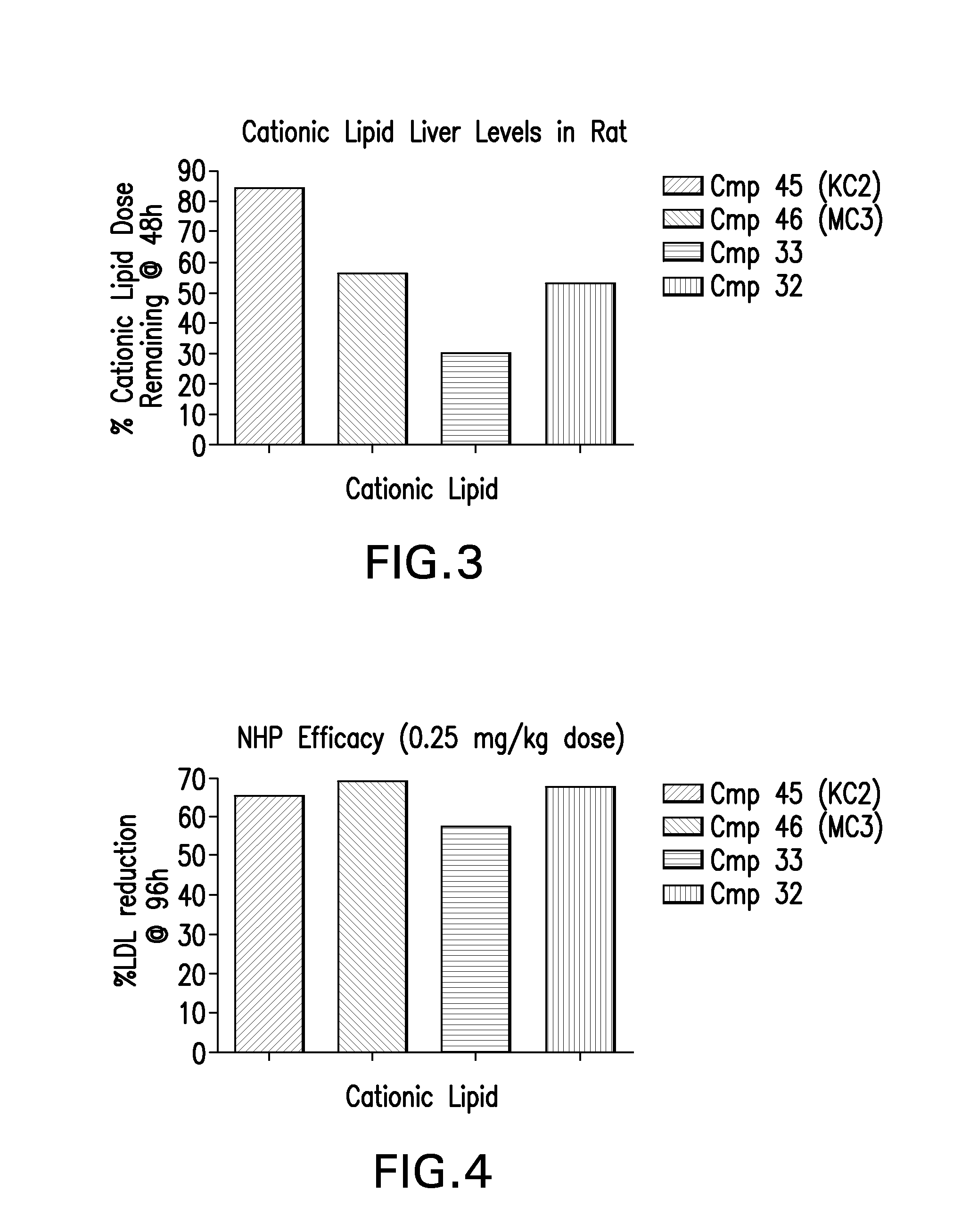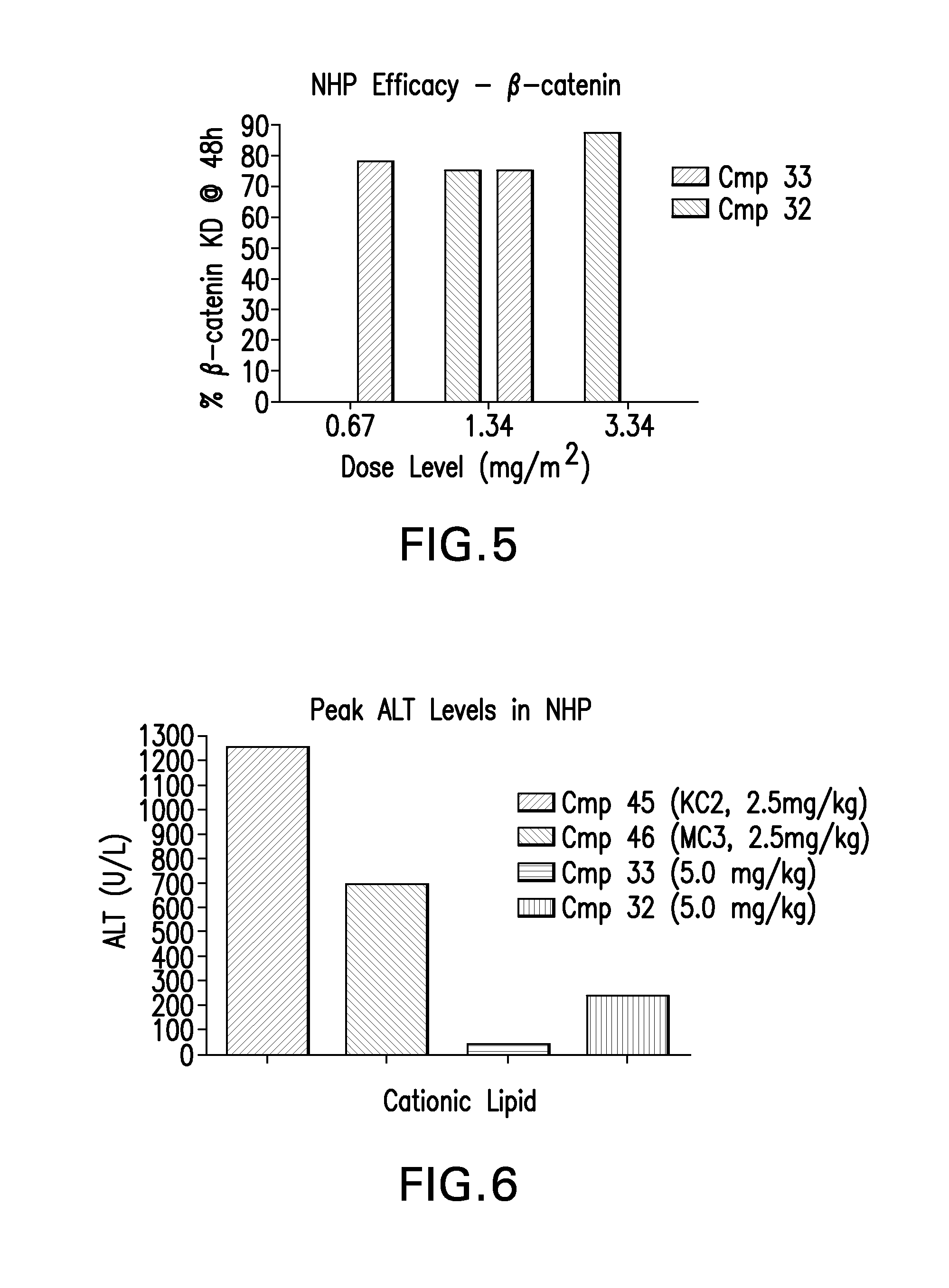Novel low molecular weight cationic lipids for oligonucleotide delivery
a cationic lipid, low molecular weight technology, applied in the preparation of n-o/n-n bonds, drug compositions, biocide, etc., can solve the problems of non-optimal delivery efficiency, achieve enhanced efficacy, lower liver toxicity, and reduce lipid levels in the liver
- Summary
- Abstract
- Description
- Claims
- Application Information
AI Technical Summary
Benefits of technology
Problems solved by technology
Method used
Image
Examples
example 1
Mouse in Vivo Evaluation of Efficacy
[0225]LNPs utilizing Compounds 1-44, in the nominal compositions described immediately above, were evaluated for in vivo efficacy. The siRNA targets the mRNA transcript for the firefly (Photinus pyralis) luciferase gene (Accession # M15077). The primary sequence and chemical modification pattern of the luciferase siRNA is displayed above. The in vivo luciferase model employs a transgenic mouse in which the firefly luciferase coding sequence is present in all cells. ROSA26-LoxP-Stop-LoxP-Luc (LSL-Luc) transgenic mice licensed from the Dana Farber Cancer Institute are induced to express the Luciferase gene by first removing the LSL sequence with a recombinant Ad-Cre virus (Vector Biolabs). Due to the organo-tropic nature of the virus, expression is limited to the liver when delivered via tail vein injection. Luciferase expression levels in liver are quantitated by measuring light output, using an IVIS imager (Xenogen) following administration of the...
example 2
[0226]LNPs are incubated at 37° C. in 90% rhesus serum at a final LNP concentration of 4 ug / mL. Incubation is for 20 minutes with orbital rotation. After incubation, the samples are diluted 1:20 in PBS and 100 uL of each diluted sample is aliquoted to wells of an anti-PEG antibody coated 96-well plate (Life Diagnostics Cat. No. P-0001PL. After incubation at room temperature for 1 hour, the plate is washed 5× with 300 uL PBS. After washing, 50 uL of 0.2% Triton X-100 is added to each well and the plate incubated at 37° C. for 10 minutes, followed by shaking on a plate shaker for 1 minute at 750 rpm. Samples are frozen prior to performing the ApoE ELISA and stem loop PCR analysis of samples.
[0227]An ApoE ELISA assay is performed to quantitate ApoE bound to the LNPs after incubation in rhesus serum. Anti-ApoE antibody (Milipore, Cat No. AB947) is diluted 1:1000 in PBS and 100 uL of diluted antibody is added to each well of a polystyrene high binding plate. Th...
example 3
Heparin Sepharose HI-TRAP™ Binding Assay
[0238]Lipid nanoparticles (LNP) with neutral surface charge are not retained after injection onto heparin sepharose with 1× Dulbecco's phosphate buffered saline (DPBS) as the running buffer but elute in the column void volume. Serum apolipoprotein E (ApoE) exhibits high affinity binding with heparin sulfate and it was shown that LNPs bind to heparin sepharose to an extent dependent on their intrinsic ability to bind ApoE (depending on both lipid nanoparticle composition and ApoE concentration) after incubation with purified and / or recombinant human ApoE or serum samples. Lipid nanoparticles with surface bound ApoE bind to heparin sepharose with high affinity and are eluted only at high salt (1M NaCl).
[0239]A heparin sepharose binding assay was developed to assess serum ApoE binding to lipid nanoparticles based on the high affinity interaction that ApoE-LNP complexes exhibit toward heparin sepharose.
Incubations
[0240]Lipid nanoparticles were inc...
PUM
| Property | Measurement | Unit |
|---|---|---|
| Molar density | aaaaa | aaaaa |
| Molar density | aaaaa | aaaaa |
| Molar density | aaaaa | aaaaa |
Abstract
Description
Claims
Application Information
 Login to View More
Login to View More - R&D
- Intellectual Property
- Life Sciences
- Materials
- Tech Scout
- Unparalleled Data Quality
- Higher Quality Content
- 60% Fewer Hallucinations
Browse by: Latest US Patents, China's latest patents, Technical Efficacy Thesaurus, Application Domain, Technology Topic, Popular Technical Reports.
© 2025 PatSnap. All rights reserved.Legal|Privacy policy|Modern Slavery Act Transparency Statement|Sitemap|About US| Contact US: help@patsnap.com



